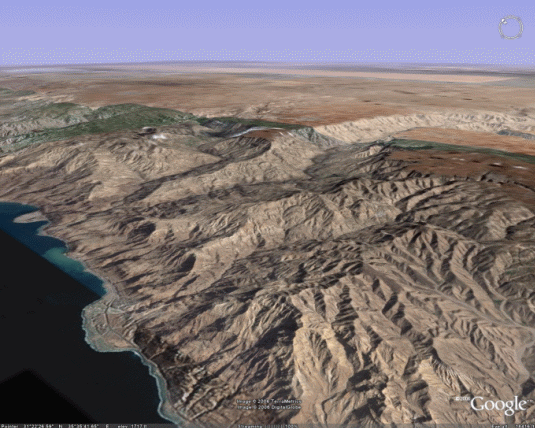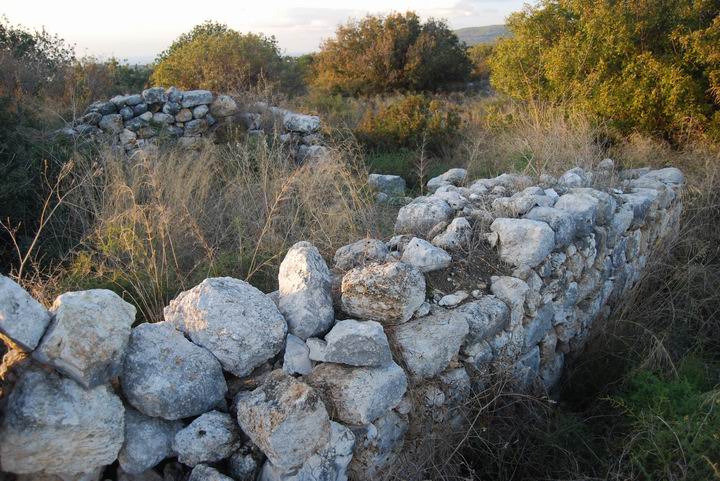I'm deeply fascinated by the Middle East, and I've been following the Civil War in Syria since its beginning in 2011. When the fighting finally reached Damascus (long-regarded for its beauty), my first thought was "Oh no! Old Damascus is a World Heritage Site!"
However, fighting in the Middle East is certainly nothing new. Civilization was born there, so they also got a head-start on self-destruction. The three Abrahamic religions (Judaism, Christianity, and Islam) all got their start in this desert wasteland that I suppose only appears to be godforsaken. If it actually were, I doubt we would still be trying desperately to cover up each other's holy sites with those of our own.
So, without further ado, I present to you a mostly-safe armchair tour of biblical places. (The holy sites of other faiths and the New Testament will be covered in subsequent posts.)

The Abana River flows just west of Damascus (2 Kings 5.12). Today it's called the Barada. The Abana led to the prosperity of Damascus, but it's now much lower and seriously polluted. Abana means golden stream in Ancient Greek. Its modern name derives from the Arabic word for cold.

The Abarim Mountains are in southern Jordan (Deut 3.27). The name means passages. Mt. Nebo is its highest point.

Abdon can also be spelled Hebron, and about a half dozen other ways (Josh 21.30). It means servile in Hebrew. It was settled by the tribe of Asher. It was located in in what is now Israel, a few miles from the Mediterranean coast, 8 miles south of the port city of Tyre. According to Bible Walks, the site was first built up during the Middle Bronze Age (c 4000 years ago). The Asherites settled there during the Iron Age (c 3200 ya). As related in 2 Kings, the site was invaded and destroyed by the Neo-Assyrians in c 733 BC. Beginning in the 5th century BC, the site was resettled by Persians and Greeks. The Romans and Byzantines fortified the city. The Crusaders used the site, and in 1220 it belonged to the De Milly family. After the last Crusaders were driven out, the site fell into ruin.

Abel-beth-maachah (2 Sam 20.19) means Meadow of the House of Maachah. The site is located in northern Israel, just over the border from Lebanon. It was first settled during the 3rd millennium BC and was destroyed c 733 BC, by the Neo-Assyrians. Though it eventually became an Israelite city, it was originally Aramean, and may have even been the capital of the kingdom of Aram. The site was occupied up through the Ottoman period. Little is definitively known about the site, however, as its first excavation season is currently ongoing. More information on the site and excavation can be obtained at the expedition website.

Abel-meholah was the birthplace of the prophet Elisha (1 Kings 4.12). It's in Lebanon. Today the site is called 'Ain al-Hilweh, or sweet spring. It is the largest Palestinian refugee camp in Lebanon, with over 70.000 inhabitants. It became a refugee camp in 1948 and is still there. The image is from Doctors Without Borders, and shows what appears to be Roman-era ruins in the background.

Abel-Shittim, Meadow of Acacias, is also known as Abila in the writings of Josephus (Num 25.1). It was located in Jordan, in a fertile region. According to the Bible, this is where Joshua's headquarters were just before the Israelites crossed the Jordan. Today it is called Abel-ez-Zeit. According to the World Monument Fund, it was occupied from 8000 BC to the Late Roman period. It was destroyed by an earthquake in 746 and subsequently abandoned. The site sounds amazing- excavations have revealed huge public buildings and a theatre from the Roman period, an early Christian basilica, early Umayyad ruins, and a Roman necropolis with intact frescoes. Unfortunately, poor maintenance and site security has led to erosion, decay, and frequent looting. However, since its placement on the WMF's watchlist in 2011, steps have been taken to improve conditions.

Abronah, passage, is located in Israel (Num 33.34). It was a very important trade route, linking Lebanon, the Dead Sea, the Horn of Africa, Egypt, and Thebes.

Akkad was the capital of the Akkadian Empire, which reached its height of power at the end of the 3rd millennium BC (Gen 10.10). For centuries the only reference to its existence was a mention in Genesis 10.10. Now, however, cuneiform tablets confirm the city's existence. Still, the location of Akkad is unknown, though it was likely somewhere to the east of the Tigris. The statue base shown above mentions the building of a temple in Akkad. (Sorry, you'll just have to take the Internet's word for it.) The etymology of the name is uncertain. The best theory I could find regarding Akkad's location proposes that it was the site known as Qadisiyeh. A fragment of a massive Akkadian statue has been found there, and this location doesn't contradict any details given in known contemporary sources.


Acre is a city in Israel originally known as Accho (Judges 1.30). The etymology is unknown. The Book of Job (38.11) relates an ancient Hebrew legend that provides a folk etymology: the sea flooded but stopped at the city of Acre, when God said "Hitherto you shall come, but go no further." The Hebrew hitherto is transliterated ad ko. Acre is one of the oldest continuously inhabited cities on earth, since about 3000 BC.
It was first a Canaanite settlement, then a territory of the tribe of Asher (one of the 12 Tribes of Israel), controlled by King Solomon, Alexander the Great, and Ptolemy Soter in antiquity. The Greeks called it Ake, cure, because in myth, Heracles found herbs there to heal his wounds. Alexander called it Antiochia Ptolemais. The Persians were based there when they invaded Egypt. In c 165 BC, Judas Maccabeus drove the Seleucids into the city, and fifteen years later, Jonathan Maccabeus was betrayed and taken prisoner there. It was again conquered by the Israelites, then the Egyptians under Cleopatra VII (that Cleopatra), and the Armenians. Herod built a massive gym in the city, St Paul hung out there in Acts 21, it became a Roman colony, then part of the Byzantine Empire.
In 638, Acre fell under Islamic rule and the Caliph encouraged Persian settlement in the city. Christians controlled the city and its strategic harbor in the 12th and 13th centuries, and it was the final Crusader stronghold in the area. The Mamluks regained control in 1291, and most of the city was destroyed to prevent recapture by the French. Even in ruins, writers still praised Acre's beauty. The Ottomans captured the city in 1517, and by the turn of the 17th century it was nearly abandoned. In the 18th century, the city underwent a revival under the rule of a minor autonomous sheikh. Napoleon tried to capture the city in 1799, and laid siege to it for two months. But even with the help of the British, the French never breached the walls. It was bombarded by British, Austrian, and French troops in 1840, during the Oriental Crisis, and Ottoman rule returned in 1841. It was occupied by the British in the final days of the Great War, and became a British Mandate in 1922. It was captured by Israel in 1948. It remains a diverse city, with a mixed population of Jews and Arabs. 67% of residents are Jews, 25% are Muslim, 2.5% are Arab Christians, and there are small but thriving Druze and Baha'i populations. It is the holiest city of the Baha'i faith.

Akeldama means field of blood in Aramaic. It is in Jerusalem and is also known as Potter's Field for its rich red clay. Until the early 19th century, non-Jews were buried there. Patients from the Crusader hospital were buried there as well. Christian legend states that this is where Judas Iscariot hanged himself. Crusaders built an enormous building for sepulchres on the site, though the building is in ruins. Armenian Christians have owned the site since the 16th century, and a Greek Orthodox Monastery was built there in 1892.
Grace and peace be with you,
Callie R.
No comments:
Post a Comment